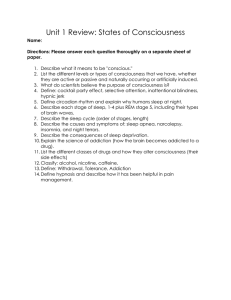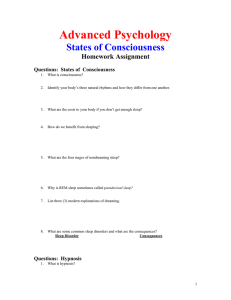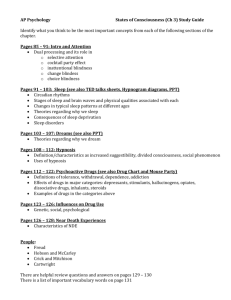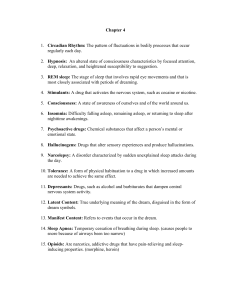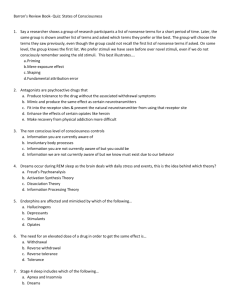AP Psychology
advertisement
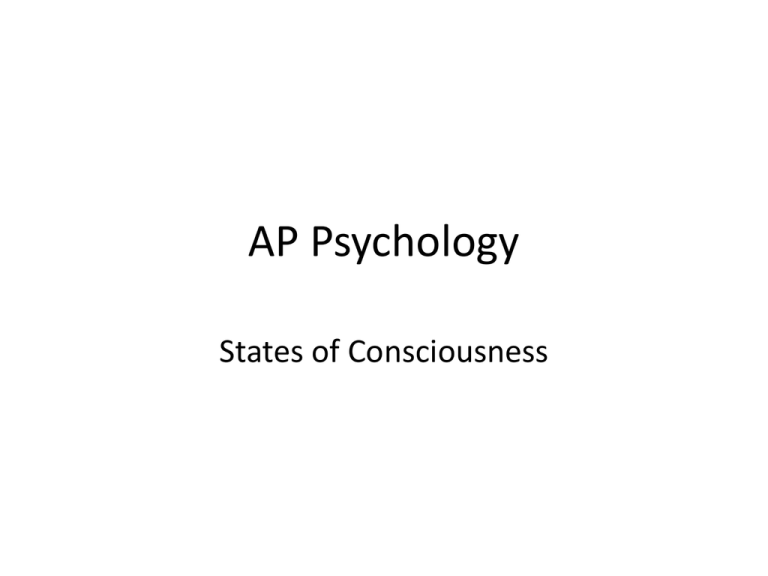
AP Psychology States of Consciousness activation-synthesis theory on dreams First proposed in 1977 by John Allan Hobson and Robert McCarley at Harvard University, the activation-synthesis theory suggests that REM sleep triggers changes in neural activity that initiates the brainstem. This change in activity, which the theory supposes happens throughout the day at different levels, creates the content for REM sleep. cognitive information processing theory on dreams The cognitive information processing theory on dreams suggest that cognitive functions are the same when one is awake and when one is asleep. Therefore, the brain is engaged in the same functions in dreaming such as problem solving. Various people have suggested that many of their ideas came to them in dreams. Robert Plant and Jimmy Page of Led Zeppelin have spoken about songs coming to them in dreams. Robert Louis Stevenson said the idea for Dr. Jekyll and Mr. Hyde was the product of a dream and Elias Howe said the same about his invention of the sewing machine. consciousness Consciousness refers to a state of awareness, including a person’s feelings, sensations, ideas and perceptions. Though definitive in the explanation above, it is otherwise a much murkier concept to explore. According to British psychologist Stuart Sutherland, “(Consciousness is) a fascinating but elusive phenomenon: it is impossible to specify what it is, what it does, or why it evolved. Nothing worth reading has been written about it.” levels of consciousness: Circadian rhythms The circadian rhythm is a term describing one’s biological clock – the time of activity and non-activity over the course of twenty-four hours. This pattern of behavior is established, created by one’s environment and the twenty-four day. levels of consciousness: daydreaming During periods of wakefulness, daydreaming is when a person begins to lose focus on their immediate surroundings and focus on something else. Traditionally, this is not seen as terribly productive but an exercise of whimsy. levels of consciousness: drug-induced states A drug-induced state is simply a level of consciousness brought on by the usage of psychoactive drugs. Its effects can range from relaxation and feelings of euphoria to the creation of mentally destabilizing conditions that, if taken to excess, can cause permanent brain damage and death. levels of consciousness: hypnosis Hypnosis is a state of consciousness characterized by focused attention and increased suggestibility. It is not sleep. Rather, it is an extreme focus on internal stimuli. Hypnosis is commonly used by psychologists. Theodore Barber (1965) suggested there was nothing special about hypnosis but rather, it is something that can be achieved with effort. Ernest Hilgard (1986) felt that hypnosis, in contrast, was quite constructive and potentially helpful. Posthypnotic suggestion is one made while under hypnosis that influences the patient’s behavior afterwards. levels of consciousness: hypothalamus The hypothalamus controls hunger, thirst, sexual behavior and reactions to temperatures. It also activates the sympathetic and parasympathetic systems as well as the release of hormones from the pituitary gland. It is also thought that along with the limbic system, medulla and thalamus, the hypothalamus serves a function with REM sleep. levels of consciousness: meditation Meditation requires the focusing of attention to clear the mind and to induce relaxation. There are three types of meditation: Transcendental – repetition of a mantra for roughly 20 minutes, twice a day Mindfulness – the meditation focuses on different parts of the body, from head to toe with particular attention on those parts that cause pain Breath – concentration on inhaling and exhaling levels of consciousness: preconscious An entire career of observations led Freud to conclude that there were different levels of awareness and sought to define and related them to one another. This includes the conscious, preconscious and unconscious. One’s preconscious contains material just beneath the surface of awareness that can easily be retrieved. This can include a good friend’s middle name, what you had for dinner last night and an argument you had last week. levels of consciousness: reticular formation Running through the center of the brainstem, passing through the hindbrain and midbrain, the reticular formation is a part of the brain that helps to modulation of muscle reflexes, breathing and pain perception. One of its most important is its regulation of sleep and arousal. levels of consciousness: unconscious An entire career of observations led Freud to conclude that there were different levels of awareness and sought to define and related them to one another. This includes the conscious, preconscious and the unconscious. One’s unconscious contains thoughts, memories and desires that are well below the surface of conscious awareness but that nonetheless exert great influence on behavior. manifest and latent content of dreams According to Freud, dreams have several layers of meaning. The manifest content of dreams are made up of the actual images – be it a classroom, a field, vision of people long passed or animals. The latent content of dreams is the meaning behind the images, revealing the wishes of the dreamer. physiological dependence (addiction) With physiological dependence, the human body grows dependent upon some drug or other foreign substance. psychoactive drugs The purpose of psychoactive drugs is to impact the central nervous system and produce an alternate consciousness. These drugs can range from the ubiquitous (coffee) to the prescribed (Ambien) to the illegal and dangerous (marijuana and LSD). Depressants Hallucinogens – also known as psychedelics, are drugs that can create hallucinations, such as LSD. There are other opiates that can also produce hallucinations. Narcotics Stimulants Cannabis Alcohol psychological dependence With psychological dependence, a person must continue to take a drug to satisfy intense mental and emotional craving for the drug. Psychological dependence is possible with all recreational drugs. sleep stages Stage 1 – During this stage, there is a general relaxation with irregular breathing and brain waves. Typically, this lasts 10 minutes. Stage 2 – Here, the brain shifts from low-amplitude, high frequency waves to high amplitude, low frequency waves; this is accompanied by the slow, side-to-side movement of the eyes. This tends to last 30 minutes. Stage 3 – During this stage, large amplitude delta waves begin sweeping the brain every couple of seconds or so. Stage 4 – This stage is the deepest sleep a person experiences. Suddenly awaken from this stage creates disorientation. During this stage, night terrors, sleepwalking and bed-wetting occur. REM – Lasting 15-45 minutes a night, this is the most active period where one’s body responds as if awake to the images produced in your consciousness. sleep disorders: insomnia Insomnia is the condition of seldom getting more than one or two hours of sleep a night on a regular basis. The causes of this are a varied as the people who suffer with the condition. Long-term insomnia can create serious health conditions. sleep disorders: narcolepsy Narcolepsy is a condition where one falls asleep often or is very tired throughout the period of being awake. Irregular sleep patterns can cause narcolepsy and such a condition can cause serious problems with work and leisure time, as well as interpersonal relationships. sleep disorders: nightmares and night terrors Nightmares are common but scary dreams that occur during REM sleep. Typically, people will awake before the worst happens in such a dream. Night terrors, which occur in stage IV sleep, can last as long as twenty minutes and is typically accompanied by screaming, sweating and confusion, as well as rapid heart rate. Unlike nightmares, people seldom have memories of the terror itself. sleep disorders: sleep apnea Sleep apnea is a disorder where a person has difficulty breathing while sleeping. This is typically accompanied by snoring, a condition where the person is actually choking. Most of the causes center on physical defects, as opposed the mental stress that causes insomnia. sleep disorders: sleepwalking Sleepwalking (also known as somnambulism) is a condition where the person is part awake, part asleep. There is no memory left over by the sleepwalker of what they did or how long. It is typically seen in children though adults also can suffer. Scientists have linked sleep walking to stress and the use of sedatives but there is also proof that it is inherited. In theory, it is harmless but if the person falls or walks into a dangerous situation (into a street), it can be quite harmful. withdrawal symptoms Withdrawal symptoms refer to a host of physical reactions when there is a decline in or elimination of addictive or psychological dependent drugs. The severity and danger of withdrawals depend a great deal on the drug in question, how long it has been used and to what extent.

